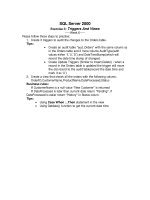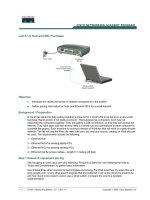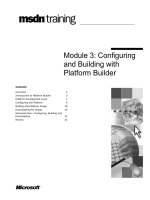onur 740 fall13 module5 1 3 simd and gpus part3 vliw dae systolic
Bạn đang xem bản rút gọn của tài liệu. Xem và tải ngay bản đầy đủ của tài liệu tại đây (976.73 KB, 62 trang )
Computer Architecture:
SIMD and GPUs (Part III)
(and briefly VLIW, DAE, Systolic
Arrays)
Prof. Onur Mutlu
Carnegie Mellon University
A Note on This Lecture
These slides are partly from 18-447 Spring 2013,
Computer Architecture, Lecture 20: GPUs, VLIW, DAE,
Systolic Arrays
Video of the part related to only SIMD and GPUs:
/>PHm2jkkXmidJOd59REog9jDnPDTG6IJ&index=
20
2
Last Lecture
SIMD Processing
GPU Fundamentals
3
Today
Wrap up GPUs
VLIW
If time permits
Decoupled Access Execute
Systolic Arrays
Static Scheduling
4
Approaches to (Instruction-Level)
Concurrency
Pipelined execution
Out-of-order execution
Dataflow (at the ISA level)
SIMD Processing
VLIW
Systolic Arrays
Decoupled Access Execute
5
Graphics Processing Units
SIMD not Exposed to Programmer
(SIMT)
Review: High-Level View of a
GPU
7
Review: Concept of “Thread Warps”
and
SIMT
Warp: A set of threads that execute the same
instruction (on different data elements) SIMT
(Nvidia-speak)
All threads run the same kernel
Warp: The threads that run lengthwise in a woven fabric …
Thread Warp
Common PC
Scalar Scalar Scalar
ThreadThread Thread
W
X
Y
Scalar
Thread
Z
Thread Warp 3
Thread Warp 8
Thread Warp 7
SIMD Pipeline
8
Review: Loop Iterations as
Threads
for (i=0; i < N; i++)
C[i] = A[i] + B[i];
Vectorized Code
Scalar Sequential Code
load
load
Iter. 1
add
store
load
load
Iter. 2
load
load
Time
load
Iter.
1
load
add
add
store
store
Iter.
2
Vector Instruction
add
store
Slide credit: Krste Asanovic
9
Review: SIMT Memory Access
Same instruction in different threads uses thread id
to index and access different data elements
Let’s assume N=16, blockDim=4 4 blocks
+
0
1
2
3
4
5
6
7
8
9
0
1
2
3
4
5
6
7
8
9
+
Slide credit: Hyesoon Kim
+
+
1
0
1
0
1
1
1
1
1
2
1
2
1
3
1
3
+
1
4
1
4
1
5
1
5
Review: Sample GPU SIMT Code
(Simplified)
CPU code
for (ii = 0; ii < 100; ++ii) {
C[ii] = A[ii] + B[ii];
}
CUDA code
// there are 100 threads
__global__ void KernelFunction(…) {
int tid = blockDim.x * blockIdx.x + threadIdx.x;
int varA = aa[tid];
int varB = bb[tid];
C[tid] = varA + varB;
}
Slide credit: Hyesoon Kim
Review: Sample GPU Program (Less
Simplified)
Slide credit: Hyesoon Kim
12
Review: Latency Hiding with “Thread
Warps”
Warp: A set of threads that
execute the same instruction
(on different data elements)
Fine-grained multithreading
Thread Warp 7
Slide credit: Tor Aamodt
ALU
Graphics has millions of pixels
RF
ALU
ALU
SIMD Pipeline
Decode
RF
Warps available
for scheduling
I-Fetch
RF
One instruction per thread in
pipeline at a time (No branch
prediction)
Interleave warp execution to
hide latencies
Register values of all threads stay
in register file
No OS context switching
Memory latency hiding
Thread Warp 3
Thread Warp 8
D-Cache
All Hit?
Data
Writeback
Warps accessing
memory hierarchy
Miss?
Thread Warp 1
Thread Warp 2
Thread Warp 6
13
Review: Warp-based SIMD vs.
Traditional SIMD contains
Traditional
SIMD a single thread
Lock step
Programming model is SIMD (no threads) SW needs to know vector
length
ISA contains vector/SIMD instructions
Warp-based SIMD consists of multiple scalar threads executing in
a SIMD manner (i.e., same instruction executed by all threads)
Does not have to be lock step
Each thread can be treated individually (i.e., placed in a different
warp) programming model not SIMD
SW does not need to know vector length
Enables memory and branch latency tolerance
ISA is scalar vector instructions formed dynamically
Essentially, it is SPMD programming model implemented on SIMD
hardware
14
Review: SPMD
Single procedure/program, multiple data
Each processing element executes the same procedure, except on
different data elements
This is a programming model rather than computer
organization
Procedures can synchronize at certain points in program, e.g. barriers
Essentially, multiple instruction streams execute the same
program
Each program/procedure can 1) execute a different control-flow path,
2) work on different data, at run-time
Many scientific applications programmed this way and run on MIMD
computers (multiprocessors)
Modern GPUs programmed in a similar way on a SIMD computer
15
Branch Divergence Problem in Warpbased
SIMD
SPMD Execution on SIMD Hardware
NVIDIA calls this “Single Instruction, Multiple Thread”
(“SIMT”) execution
A
Thread Warp
B
C
D
F
Common PC
Thread Thread Thread Thread
1
2
3
4
E
G
Slide credit: Tor Aamodt
16
Control Flow Problem in
GPUs/SIMD
GPU uses SIMD
pipeline to save area
on control logic.
Group scalar threads
into warps
Branch divergence
occurs when threads
inside warps branch
to different
execution paths.
Slide credit: Tor Aamodt
Branch
Path A
Path B
17
Branch Divergence Handling (I)
Stack
AA/1111
Reconv. PC
TOS
TOS
TOS
BB/1111
C/1001
C
D/0110
D
F
G
A
B
E
D
C
E
Active Mask
1111
0110
1001
Common PC
Thread Warp
EE/1111
Thread Thread Thread Thread
1
2
3
4
G/1111
G
A
E
E
Next PC
B
C
D
E
G
A
Time
Slide credit: Tor Aamodt
18
Branch Divergence Handling (II)
A;
if (some condition) {
B;
} else {
C;
}
D;
A
One per warp
TOS
Control Flow Stack
Next PC Recv PC Amask
D
A
-1111
B
D
1110
C
D
D
0001
Execution Sequence
B
C
D
Slide credit: Tor Aamodt
A
1
1
1
1
C
0
0
0
1
B
1
1
1
0
D
1
1
1
1
Time
19
Dynamic Warp Formation
Idea: Dynamically merge threads executing the
same instruction (after branch divergence)
Form new warp at divergence
Enough threads branching to each path to create full
new warps
20
Dynamic Warp
Formation/Merging
Idea: Dynamically merge threads executing the same
instruction (after branch divergence)
Branch
Path A
Path B
Fung et al., “Dynamic Warp Formation and Scheduling for
Efficient GPU Control Flow,” MICRO 2007.
21
Dynamic Warp Formation
Example
A
x/1111
y/1111
A
x/1110
y/0011
B
x/1000
Execution of Warp x
at Basic Block A
x/0110
C y/0010 D y/0001 F
E
Legend
A
x/0001
y/1100
Execution of Warp y
at Basic Block A
D
A new warp created from scalar
threads of both Warp x and y
executing at Basic Block D
x/1110
y/0011
x/1111
G y/1111
A
A
B
B
C
C
D
D
E
E
F
F
G
G
A
A
Baseline
Time
Dynamic
Warp
Formation
A
A
B
B
C
D
E
E
F
G
G
A
A
Time
Slide credit: Tor Aamodt
22
What About Memory
Divergence?
Modern GPUs have caches
Ideally: Want all threads in the warp to hit (without
conflicting with each other)
Problem: One thread in a warp can stall the entire
warp if it misses in the cache.
Need techniques to
Tolerate memory divergence
Integrate solutions to branch and memory divergence
23
NVIDIA GeForce GTX 285
NVIDIA-speak:
240 stream processors
“SIMT execution”
Generic speak:
30 cores
8 SIMD functional units per core
Slide credit: Kayvon Fatahalian
24
NVIDIA GeForce GTX 285 “core”
64 KB of storage
for fragment
contexts
(registers)
…
= SIMD functional unit, control
shared across 8 units
= multiply-add
= multiply
Slide credit: Kayvon Fatahalian
= instruction stream decode
= execution context storage
25









